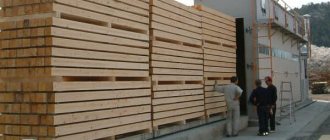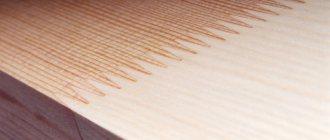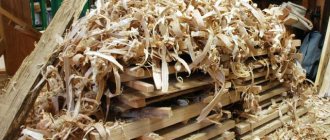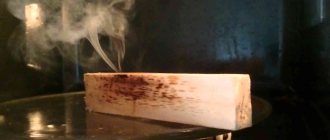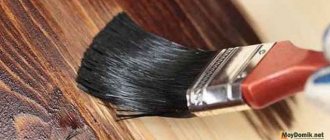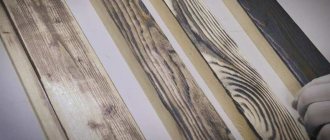In this article:
- Humidity indicators
- Why is proper drying so important?
- Methods for professional drying of wood
Wood is a hygroscopic material that naturally contains moisture and has the ability to absorb it from the atmosphere. Lumber goes on sale in two forms: natural moisture and dried. Of course, the latter are more expensive, so many entrepreneurs, when equipping a sawmill, think about ways to dehydrate the wood.
Humidity indicators
Based on the degree of humidity, the following states of wood are distinguished:
- wet (100% humidity) – logs that have been in water for a long time (for example, transported by rafting);
- freshly cut – humidity depends on the natural growing conditions of the plant, and ranges from 50-100%;
- air-dry - material that is stored in the air (under a canopy) reaches parameters of 12-20%;
- room-dry (8-12%) – drying in a closed, heated and well-ventilated room;
- dry (humidity less than 8%) – prepared by forced moisture release.
The advantages of such a boiler
This drying is the most effective and suitable option. He has the following qualities:
- it does not depend in any way on weather conditions;
- a small amount of defects;
- all work is automated;
- convenient and simple program management;
- ultimately we obtain wood with the required moisture content;
- maintains uniform drying and shape.
Such drying boilers can solve several problems at once and, according to their characteristics, are the most economical equipment for drying wood.
Hello dear readers and subscribers of Andrey Noak's Blog! Today we will look at how a wood-fired lumber dryer works. Let's find out how to make it and consider whether it is profitable to heat with wood? Of course, we will consider small drying chambers that are suitable for small production or at home.
Let me start by saying that I came across this technology when I was working at a large woodworking enterprise, which one? And you look at my biography and find out! There were several dryers there, some made of brick, others made of sandwich panels. This furnace was paired with a sawdust vortex and, in addition to the drying chambers, also heated the sawmill and molding production shops. Then I came across drying chambers heated with regular coal.
Why is proper drying so important?
Boards with natural moisture are larger in size than dried ones and are cheaper. This is because lumber manufacturers set tolerances based on future shrinkage and trimming.
Humidity standards:
- for building and carpentry materials – 10-18%. When manufacturing building materials, the production moisture content of wood should be equal to or be 1.25-3.5% lower than the operational moisture content in order to avoid natural drying.
- for furniture production – 8-10%.
The use of lumber with natural moisture is a gross violation of the technological process . When the wood dries naturally, it will change the width, thickness and, accordingly, the geometry of the entire product.
For example, a 50*150mm edged pine board with a natural humidity of more than 50% after a couple of months will have parameters of 48 * 138 mm (for tangential cutting) and 46 * 144 (for radial cutting). Even if we take into account that the length of the product will remain the same (on average, the deviation does not exceed 0.1%), the final difference is catastrophic!
Flaws
- The disadvantages I would include is the impossibility of automating the process, so you need to constantly monitor the process and maintain the temperature;
- The next point comes from the previous point - the impossibility of one person monitoring several boilers. This is due to the fact that chocks need to be constantly thrown and cooked;
- The need for additional preparation of fuel, the logs must be sawed, and sometimes even split;
- There must be a person next to the boiler constantly, day and night, who would add firewood and monitor the temperature, and this increases the cost of drying;
- Since the process is not automated based on temperature, I know from experience that situations will arise when the temperature is “too late,” which in turn will lead to defects in the drying of lumber (blue stains, cracks, fungus, rot).
Methods for professional drying of wood
Convective (chamber) drying
The most popular type of drying equipment is convection chambers. About 80% of manufacturers use just such dryers.
Advantages: ease of use, high rate of moisture evaporation, low voltage in the final product, high loading volume (up to 1000 m3).
Supply and exhaust ventilation and heating systems (usually air heaters) are installed in the room. Humidity parameters are measured by a psychrometer and adjusted automatically. Wood waste: wood chips, slabs, sawdust is used as fuel for producing hot water or steam in small production. It is profitable to use electricity and gas only for large volumes of production, otherwise the high consumption and cost of resources will significantly reduce the cost of lumber.
Centrifugal or axial (depending on the configuration) fans ensure uniform distribution of warm air and timely removal of excess moisture to avoid warping, cracking and obtain the highest quality wood in the shortest possible time.
Price – from 160,000 rubles (depending on configuration and cargo capacity).
Atmospheric drying
The natural process of evaporation of moisture from wood, which requires a minimum of investment, but a maximum of time. However, wood dehydrated by atmospheric drying is considered the most resistant to deformation. Most often this happens like this: a tree cut down at the beginning of winter is cut into planks and kept under a canopy until the start of the construction season. In 4-6 months, the lumber has time to dry to 15-20% humidity.
To avoid deformation of the boards during the drying process, the following conditions are necessary:
- stacking on a horizontal flat surface;
- to protect against excess moisture, waterproofing is laid between the rows of stacks and in the area where drying is expected;
- so that the boards are well ventilated, the stack is placed on concrete blocks and laid with timber or unedged boards of the same thickness (see figure below);
- stacks are stacked at equal intervals and parallelism;
- a prerequisite for preventing deformation is a uniform load, which is carried out using wedges or clamping bands (see figure below);
- the finished stack is protected from atmospheric influences, covered with a profile or slate. With this arrangement of the dryer, the edged board will reach 12-18% humidity in 4-5 months. The speed and quality of dehydration depends on the climate, the amount of moisture in the atmosphere and the thickness of the board. The rules for atmospheric drying are regulated by GOST 2808.1-80 for lumber from softwood and GOST 7319-80 for hardwood.
Rice. Air dryer arrangement diagram
Rice. Loading with wedges
Main disadvantages: the structure takes up a lot of space, the drying process is uncontrolled, and in areas with high humidity there is a high risk of lumber being damaged by fungus. For such terrain, it is recommended to pre-treat the boards with an antiseptic.
Vacuum dryer
Used for drying large cross-section wood, deciduous hardwood (for example, oak), valuable wood that is susceptible to cracking. The dryer is a sealed stainless steel chamber into which boards are placed between aluminum heating plates. The top of the chamber is covered with an elastic rubber covering attached to a metal frame.
Hot water continuously circulates across the plates, which is heated by an external boiler. The vacuum inside the chamber is ensured by a pump that pumps moisture out of the room.
Rice. Vacuum chamber operation diagram
A microprocessor is used to control the processes inside the chamber. For each type of wood, the operator sets his own vacuum level and plate heating temperature. For example, a beech board with a thickness of 32 mm reaches 8% humidity in 29 hours. And a pine board with a thickness of 25 mm - in 17 hours. Therefore, the main advantage of vacuum drying is the speed of processing materials .
Disadvantages: small capacity of the chambers (up to 10 m3), high energy consumption, high internal stress due to the uneven distribution of final moisture content throughout the thickness of the material. These shortcomings are eliminated in new vacuum models, where drying is carried out using hot steam.
But the price of such cameras is high: 250,000 rubles for a loading volume of 1 m3.
Microwave dryer
The essence of the “microwave” method: the wood is saturated with moisture, which then evaporates at the level of cellular structures. Dehydration of wood is carried out with high frequency currents - 915-2500 MHz.
The electromagnetic field affects stacked lumber in the space of a metal chamber. Wood is heated at a level of 50-60 degrees, therefore it is considered close to natural conditions.
Main advantages:
- mobility;
- compact dimensions;
- the drying speed is 30% higher than that of convection chambers, with relatively low energy costs (for drying 1 m3 of pine - 550 kW/h, oak - 2000 kW/h).
Flaws:
- small loading volumes (up to 4.5 m3 for hard deciduous trees and up to 7 m3 for coniferous trees);
- the high price of magnetron generators with a fairly short service life (no more than 650 hours);
- uneven drying;
- the possibility of ignition of the material inside the chamber - the microwave method is quite new, and drying modes have not yet been developed.
Assembling a wood dryer
I think it won’t be difficult to assemble a technological diagram of a wood-burning dryer:
- We are installing a drying chamber, I have a good article on this topic here.
- Then we connect the stove to the camera colorizers. The boiler should be placed directly next to the drying chamber, this will reduce heat loss.
- Remember, the smaller the volume of the heating system, the lower the heat consumption will be;
- Some small industries send water after the drying chamber to heat buildings and workshops. This water is then heated again. In each case, you need to look at it separately, but as a rule, such a system is not effective, since either the water freezes in it or they cannot reach the temperature for drying.
When choosing equipment for a dryer, from my own experience I can say:
- It is better to select a boiler in such a way that it can be heated not only with chopped wood but also with round logs. This allows you to reduce labor costs for preparing raw materials for heating;
- When choosing a furnace, you need to take into account the future raw material; if it is a slab, then the length of the firebox should allow burning long raw materials; if it is coal, the grates should be more heat-resistant. For raw materials with high heat transfer (dry bins or waste from carpentry shops), the firebox does not need to be large, but for raw materials with low heat transfer, on the contrary, you need to use large fireboxes.
What you need to pay attention to when installing a drying chamber with a wood-burning boiler
When installing a boiler, the openings in the room should allow the boiler to be changed later without dismantling the walls. For the delivery and storage of firewood, it is advisable to keep a special area near the premises where there will be a minimum of foreign impurities. This will reduce the likelihood of premature failure of the chainsaw chain in the future. Firewood is stored next to the room to make it easier to move it to the boiler room.
And I talked about the selection of sites for drying chambers, sites for storing lumber and a lot of other very useful information in my book “How work should be organized at a lumber drying site.”
Good luck and see you again. Andrey Noak was with you!
